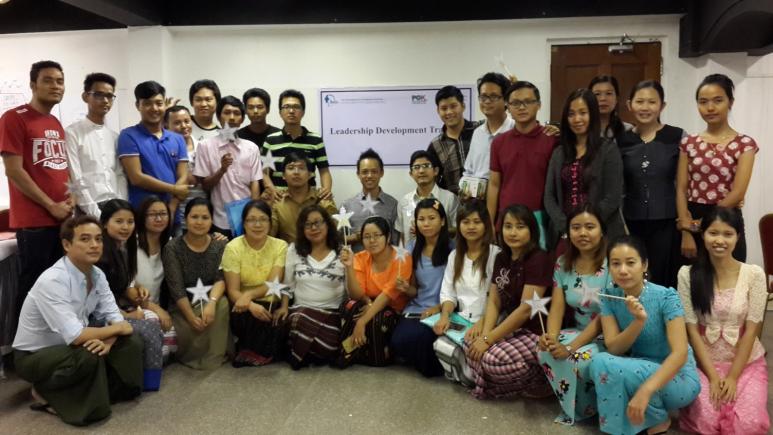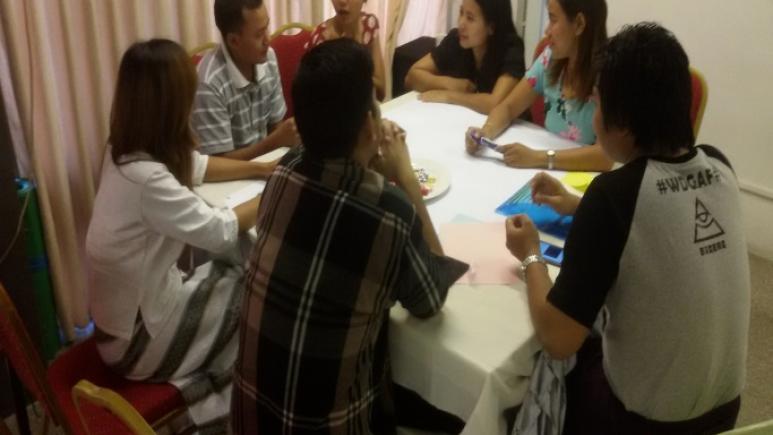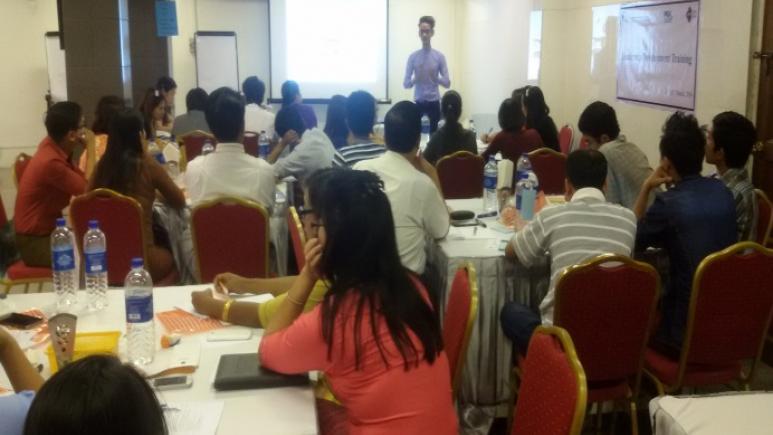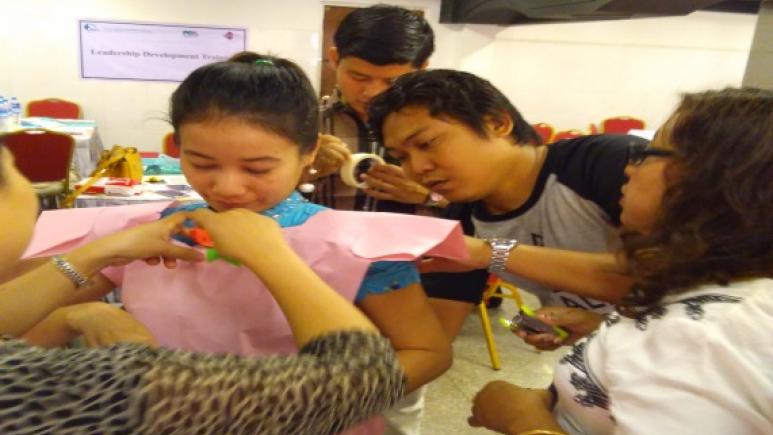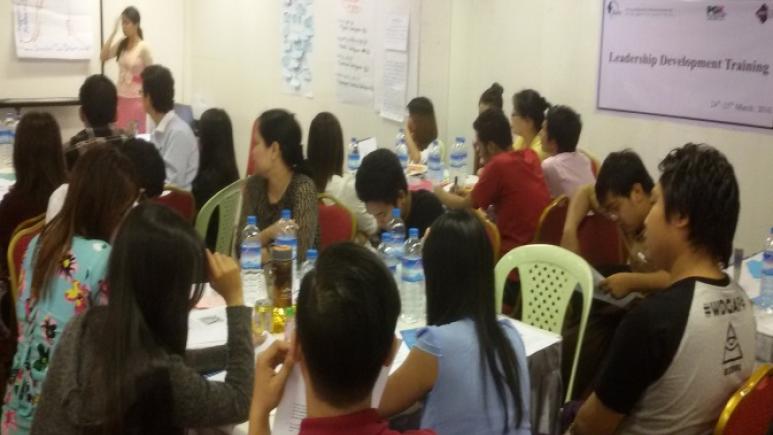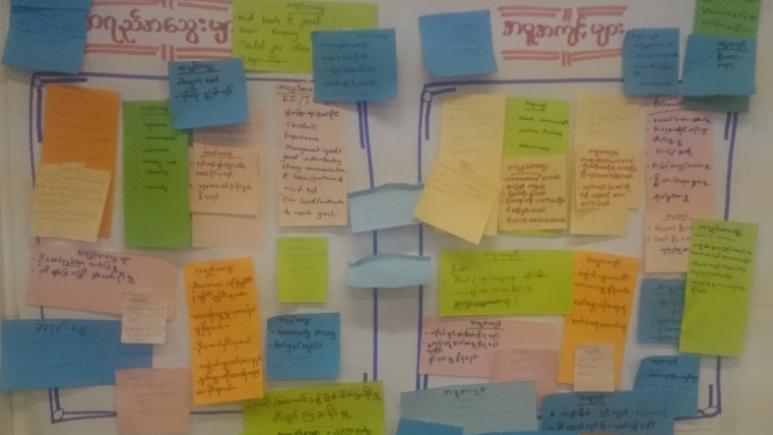Background
Pact and Pyi Gyi Khin (PGK) conducted the future step meeting in September, 2015. After the meeting, Pact OD team and PGK capacity development focal team discussed how to start the organizational development intervention. According to the discussion, Pact OD team and PGK CD focal team decided to start the PGK’s OD work plan of 2016 and prioritized the first interventions in FY-16. So, Pact conducted two days training for PGK on “Leadership Development Training” on 24th to 25th March, 2016 at Orchid Hotel. A total of 30 participants from PGK representing the different projects, different units, different levels and different geographical areas attended the training.
Basic information of the Training
Training Objective : Participants will be able to;
Date : 24th – 25thMarch, 2016 Venue : Orchid Hotel. No. of participants : 30 (Male- 14 and Female- 16) |
Key components and methodology
| No. | Topics | Methodology |
| Day (1) | ||
| 1 | Leader versus Leadership | Presentation, Discussion, Q&A |
| 2 | Difference between Leader and Manager | Presentation, Discussion, Q&A |
| 3 | What is Leadership development? | Presentation, Discussion, Q&A |
| 4 | Who can be leader? | Presentation, Discussion, Q&A |
| 5 | Characteristic or Qualities & skills of leader | Presentation, Discussion, Q&A |
| 6 | What is Leadership Function? | Group Discussion |
| Day (2) | ||
| 7 | What is Leadership Power? | Presentation, Discussion, Q&A |
| 8 | Different Leadership Style | Presentation, Discussion, Q&A |
| 9 | Situational Leadership Model | Presentation, Discussion, Q&A |
| 10 | How to Leader lead? | Presentation, Discussion, Q&A |
| 11 | How to Leader Learn? | Presentation, Discussion, Q&A |
Process
Pact Myanmar organized 2-days training on Leadership Development Training for Pyi Gyi Khin (PGK). Firstly, the facilitator tried to know the participants’ expectations and worries concerning with the training using brain storming method and then the participants set the ground rules (Dos & Don’ts) for 2 days of training. Facilitator explained the objectives of the workshop using power point. Facilitator started the first session as “Self-assessment of Leadership” that includes twenty statements link with behavior focus on leadership development for particular statement that will reflect on the current behavior of leadership and how they improved leadership skills. According to the above statement we can see all statement point out in positive side, for the participants’ behavior result, see the fig 1.
By using various methodologies, facilitator continued the session for the leadership development. Facilitator clarified the difference between leader and leadership using brain storm methods. Facilitator explained differences of leader and leadership using PowerPoint. And then, for the next session of difference between Leader and Manager, facilitator initiates the participants into two groups and let discussed about Leader and Manager. Then, they did discussion about factors on each paper and differentiate under the title of leader or manager on the wall. Each group has to explain how they differentiate on each factor and give reason why. After all factors were putting on the wall, they discussed again what they get learnt the different between leader and manager from these factors. Then they presented their finding points. Finally, facilitator explained the leader roles and manager roles. From this session, they could get the difference of leader and manager. Then, they brainstormed “How to define the Leadership development?” All of the participants defined the leadership development and so they could reflect on these. Facilitator discussed and presented the key facts of leadership development definition, after the discussion facilitator summarized the whole concept by questions and answers (Q&A) sessions.
The next session was ‘‘who can be leader?’’, using one by one debate and questions and answers (Q&A) methods which can support to acquire effective discussion. From the results of that session, the participants could be more understanding on born leader and train leader and reflecting the sense of “we all are leaders “. The qualities & skills of leader are facilitated by group discussion and Q & A method. Facilitator also discussed and presented on the importance and advantages of being having characteristic or qualities & skills of leader. After that, facilitator brainstormed on “what are the functions of a leader?” At first, participants are divided into five groups and then facilitator highlighted and discussed the common tasks and categorized the tasks. End of the session, facilitator focused and explained on the three main functions of leader as task functions, developing functions and supporting functions. At the summarization and evaluation session of day (1), facilitator summarized all topics for day (1) by reflecting learning points.
The second day of the training started with the recap session. After that, participants are organized into six groups in this session. Each group performed a role play by showing their role from their actions. All groups discussed about 5 minutes to perform 3 minutes actions. After presenting from each group, facilitator asks the rest groups which types of power they performed in the role play, how they showed their power style. All group presentation was done; facilitator explained in depth.
At the different leadership styles session, facilitator had divided into four groups and asked them to do assigned task (model of dress) the different styles of leader in each group. After the task, facilitator reflects the process and explained the different styles of leadership in different conditions. This session aimed to know different styles of a leader in different situation.
For the session “Situational Leadership Model”, facilitator used presentation and questions and answers (Q&A) methods .Facilitator explained step by step the Situational Leadership process using flip chat. Facilitator started the session with giving some experience on the specific topic with concept and activities as appetizers for the brain .To be a good leader, we must have directive behavior and supportive behavior on leadership styles. This session reflect on the whole process of effective leadership style so the participants can recall their understanding. When next session started, participants are divided into five groups using World Café method and they make discussion about “How to Leader lead and learn?” And mark notes to share others groups. Presentation and discussion completed, facilitator summarized this method with the sense between leading and learning on work. Participants can know how to lead and learn between their own lives. Finally, as the review session, all learning points from this training might be shared by each randomly one by one rotating.
Achievement
All the participants are actively involved in the whole training. Participants could not only understand the basic concepts of leadership but also the difference between leadership and management role after attending two days training. Participants learnt the leadership styles, basic concept of situational leadership model.
The most satisfying facts are that all of them have changed their attitude of leadership and got strong inspiration to lead others including superior, peers, followers and even targeted communities. Participants reflected on their experiences (personal and program) and challenges during the sessions.
In addition, this leadership training could improve trust and transparency among participants. Participants analyzed the strong points, difficulties and barriers based on the current organization situation.
Participants’ feedback from evaluation
Q1. What is the most useful part of the workshop for you?
Most of the participants mentioned the whole concept of Leadership and some participants expressed situational leadership and leadership styles while some mentioned all contents are useful and important for them.
Q2. What is the most difficult part of the workshop for you?
Most of the participants mentioned all concepts are clear so they have nothing special to point out the most difficult part of this training. But some expressed born leader and train leader and situational leadership are little difficult parts for them.
Q3. Which changes do you want to make for the workshop to be better in the future?
Most of the participants mentioned they satisfied and no special comment on the training but some people gave some suggestions like to provide with the concept for some difficult/unfamiliar words to be able to participate with full understanding.
Q4. What do you like to know more from the workshop?
Most of the participants felt they got enough concepts from this workshop but some said they want to have more knowledge on the topic of “Leadership Styles” and “Leadership Skills”.
Q5. To what extent the workshop delivery is effective? Please rate from 0 (least effective) to 10 (most effective).
Q6. Are you ready to apply what you have learned from the workshop? Please rate from 0 (not ready) to 10(completely ready).
For question 5 and 6, please see the figure 2.
Recommendation
Participants actively participated with full commitment in all 2 days of training. And also, they demonstrated strong passion to learn effective leadership concepts, and knowledge of peer mentoring relationships, not only from training tools but also from one’s experiences. They had the willingness to share training concepts and knowledge with their team again when they returned to their working environment.
Pact and PGK have good communication and collaboration for future OCD ongoing processes. Pact and PGK need to discuss for the next intervention. The main content of the training are adjusted in line with the level of participants. Course contents are also adjusted with the available time and facilitators highlighted the most topical subjects in training.
- It is better to do the follow up activities for training to enhance the effectiveness of training.
- Participants should be more study knowledge of leadership and share others
- Creating learning environment is an importance one for staff capacity development
- Participants need to adapt these knowledge and creative thinking in line with their representative area.
- Participants should set up the action plan based on the learning points from training for their development
Annex I
Attendance list
| No. | Name | Gender | Position | Project/Site |
| 1 | U Nay Win | Male | Admin/HR Officer | Yangon |
| 2 | Naw Khu Lay | Female | Finance Officer (SC) | Yangon |
| 3 | Daw Chu Chu Nwe | Female | Finance Officer (3MDG) | Yangon |
| 4 | Dr. Khay Mar Win Mg | Female | Programme Officer (HIV) | Yangon |
| 5 | Dr.Cho Cho Win | Female | ART Programme Officer | Yangon |
| 6 | Daw Khin Moe Myint | Female | Logistics Assistant | Yangon |
| 7 | Daw Thin Nwe Swe | Female | Admin Assistant | Yangon |
| 8 | U Tun Tun Win | Male | Admin/Logistics Assistant | Yangon |
| 9 | Daw Htet Htet | Female | Finance Assistant | Yangon |
| 10 | Daw May Zin Oo | Female | Field Officer | Aungban |
| 11 | Dr. Min Soe Aung | Male | Medical Officer | Aungban |
| 12 | Daw Moon Din | Female | Field Facilitator (C&S) | Aungban |
| 13 | Daw Aye Aye Thwin | Female | Field Facilitator (P) | Shwe Nyaung |
| 14 | Dr.Nay Lin Htet | Male | Field Officer | Myingyan |
| 15 | Daw May Thu Hlaing | Female | ART Promoter | Myingyan |
| 16 | Daw War War Lin | Female | Field Facilitator (C&S) | Myingyan |
| 17 | Daw Myat Mon Aye | Female | Field Finance Assistant | Myingyan |
| 18 | U Nay Myo Htun | Male | Field Facilitator (P) | Pakkoku |
| 19 | U San Win Htun | Male | Field Officer | Pathein |
| 20 | Dr. Maw Thu Tun | Female | Medical Officer | Pathein |
| 21 | U Ye Win | Male | Field officer - Case Collection | Pathein |
| 22 | Daw Hnin Wut Ye Thiek | Female | Field Finance Assistant | Pathein |
| 23 | U Win Htut Latt | Male | Field Facilitator (P) | Maubin |
| 24 | Dr. Phone Pai Min | Male | ART Programme Officer | Hintada |
| 25 | Dr. Phyo Min Thein | Male | ART Programme Officer | Maubin |
| 26 | Dr. Kaung Myat Thu | Male | ART Programme Officer | Nyaung Oo |
| 27 | Dr. Yin Mon Myint Aung | Male | ART Programme Officer | Taunggyi |
| 28 | Dr. Kyaw Nyi Win | Male | ART Programme Officer | Loilem |
| 29 | U Pyae Phyo Aung | Male | M&E Officer | Yangon |
| 30 | Dr. Thaung Htet Myat Minn | Male | Programme Officer (3MDG) | Yangon |
| Total participants (30) persons (Male-14 and Female-16) | ||||

